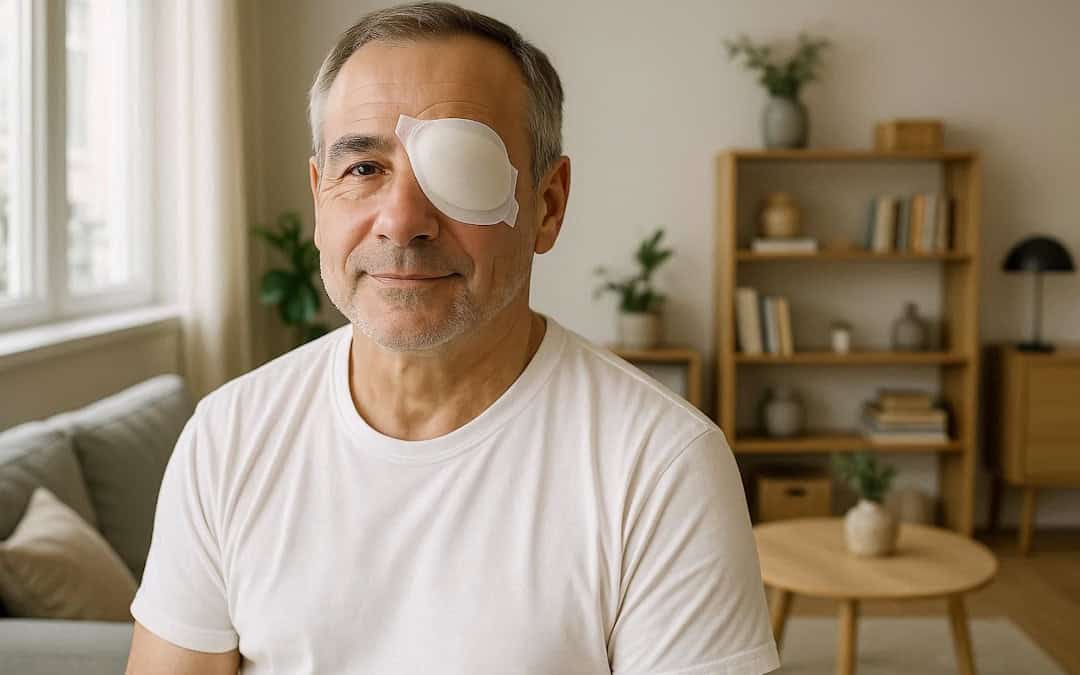Cataracts cause blindness in more people worldwide than any other condition, making your recovery timeline a critical concern. The good news is that this common procedure delivers remarkable results with about 90% success rate in improving visual clarity and typically requires only about 30 minutes to complete. While the surgery itself moves quickly, your full recovery process generally spans 4-8 weeks, though some patients heal completely within a month.
Your vision deserves the best possible healing outcome. Whether you’re scheduled for surgery next week or simply want to understand what lies ahead, the recovery process doesn’t have to feel overwhelming. Most people start noticing clearer vision within the first few days after surgery, but achieving complete healing requires following the right steps at the right times.
This guide walks you through proven strategies to speed your recovery, explains what happens during each healing phase, and identifies the activities that could slow your return to clear sight. The choices you make during recovery directly impact how quickly you’ll see the world clearly again.
What Happens During Your Recovery
Your eye follows a predictable healing pattern after cataract surgery, though individual experiences vary based on your age, overall health, and the severity of your original cataract. Understanding this timeline helps you recognize normal healing and know what to expect at each stage.
Initial recovery during the first few days
Your vision will be blurry immediately after surgery. This is completely normal and expected. Your eye may feel gritty, appear red, or produce more tears than usual during the first few days. Light sensitivity affects most patients as your pupil may remain dilated for 1-2 days after the procedure.
Your surgeon will provide a protective eye shield to wear, particularly while sleeping. This shield prevents accidental rubbing or pressure that could damage your eye as it begins healing. You’ll also receive medicated eye drops to prevent infection and reduce inflammation.
Your healing timeline: Day 1 through Week 8
Complete cataract surgery recovery typically spans 2-6 weeks, though some patients need up to 8 weeks for full healing. Here’s what you can expect during each phase:
First 24-48 hours: Your follow-up appointment checks eye pressure and monitors initial healing progress. Your vision will remain blurry but should start showing subtle improvements.
Days 3-7: Most discomfort fades as your vision gradually clears. Redness and irritation decrease noticeably during this first week after surgery.
Weeks 2-4: Significant vision improvement occurs as your eye adapts to the new lens. Light activities become comfortable again, though swimming and hot tubs remain off-limits.
Weeks 6-8: Your eye reaches full healing at this stage. If you need new eyeglasses, your eye doctor will typically provide a prescription between one and three months after surgery.
When your vision clears
Vision improvement starts remarkably quickly for most people. Many patients notice clearer sight within the first 24-48 hours after surgery. However, complete vision stabilization will take 3-10 weeks depending on your own unique circumstances.
Several factors influence how quickly your vision improves:
- Your age and overall health status
- How dense your original cataract was
- Any pre-existing eye conditions
- The specific type of surgery performed
Patients with denser cataracts often need additional time for swelling to resolve completely. Your vision will continue fine-tuning for several months as your eye fully adjusts to its new lens.
What You Can Do Now to Heal Faster
Your post-surgery choices directly determine how quickly you’ll regain clear vision. Following these evidence-based strategies can significantly reduce your healing timeline while protecting your surgical results.
Use prescribed eye drops correctly
Three different types of eye drops will become your daily companions during recovery: antibiotics to prevent infection (used for about a week), anti-inflammatory medication to reduce swelling (used for 3-6 weeks), and lubricating drops to relieve dryness.
Timing matters more than you might think. Wait 2-3 minutes between different medications to ensure proper absorption of each drop. Clean hands are non-negotiable: be sure to wash your hands thoroughly before every application.
If you’re struggling with the technique, practice with artificial tears before your surgery. Pull down your lower eyelid, look up, and place the drop in the pocket you’ve created. Here’s another helpful tip: refrigerate your lubricating drops for extra soothing relief.
Your eye shield isn’t optional
That clear plastic shield protects more than just your comfort – it safeguards your investment in better vision. Most eye care professionals recommend wearing it for approximately one week following surgery, especially during sleep when you can’t control unconscious movements.
Whether you’re taking an afternoon nap or settling in for the night, the shield prevents accidental rubbing or pressure that could damage your healing eye. One week of mild inconvenience prevents potentially undoing your successful surgery.
Don’t forget sunglasses when you step outside. Your healing eye needs protection from wind, pollen, and bright sunlight.
Eat nutritious meals to support healing
Your body needs specific building blocks to repair tissue and fight inflammation. Focus your meals around these healing powerhouses:
- Protein sources: Fish, chicken, eggs, and legumes deliver essential amino acids for tissue repair
- Vitamin C foods: Citrus fruits, strawberries, and bell peppers boost immune function and accelerate healing
- Omega-3 rich options: Salmon, tuna, and flaxseeds actively reduce inflammation
- Zinc providers: Beef, pumpkin seeds, and lentils promote faster wound healing
These nutrients work together to support eye health, control inflammation, and speed your recovery process.
Stay hydrated and get enough rest
Your eyes need proper hydration to heal effectively. Try to drink at least eight 8-oz glasses of water each day to maintain optimal moisture levels and support overall healing.
Rest doesn’t mean staying in bed all day, but it does mean respecting your body’s healing process. Avoid strenuous activities for at least a week after surgery. This includes bending over, lifting anything heavier than 10 pounds, or vigorous exercise.
Gentle walking benefits your circulation, but skip activities that cause sweating near your eye. These simple practices create the ideal environment for your eye to heal at its fastest possible pace.
What to Avoid During Your Recovery
Understanding which activities could harm your healing eye makes the difference between a smooth recovery and potential complications. These restrictions exist for important medical reasons, and following them protects the investment you’ve made in your vision.
Critical activities that risk your healing
Driving is prohibited for the first 24-48 hours after surgery since your vision will be blurry and you might feel groggy from sedation. Please respect this guideline as your safety and the safety of others depends on you to have clear vision and quick reflexes while driving.
Never rub your eyes, even when they feel itchy or uncomfortable. Rubbing transfers bacteria from your hands directly to the surgical site and can cause serious infections. Eye makeup creates similar risks, so avoid all eye cosmetics for approximately four weeks after surgery.
Avoid swimming and hot tubs
Water activities present some of the highest infection risks during recovery. Swimming pools, natural bodies of water, and hot tubs must be avoided for at least four weeks after surgery. The infection risk remains significantly elevated even if wearing goggles. Furthermore, hot tubs can harbor bacteria that pose particularly serious risks to healing eyes.
The reason for avoiding swimming and hot tubs is simple: your surgical incision hasn’t fully sealed yet, which creates a direct pathway for bacteria to enter your eye.
Screen time and light sensitivity management
It is generally acceptable to watch television after 24-48 hours, but stop immediately if you experience eye strain, increased discomfort, blurred vision, or heightened sensitivity.
Also remember that your healing eye will be more sensitive to light than usual, making sunglasses essential when outdoors to protect against wind, pollen, and bright sunlight.
Why bending and heavy lifting delay recovery
Bending forward increases pressure inside your eye, potentially disrupting the surgical wound. Keep your head above your waist level for at least 48 hours after your surgery. Similarly, lifting anything over 15 pounds during your first full week of recovery will strain your body and increase eye pressure.
Think of your eye as having a delicate repair in progress. Any activity that increases the internal pressure works against the healing process and slows down your recovery.
Exercise restrictions that protect your results
Light aerobic activities like walking, elliptical workouts, or gentle treadmill jogging are safe during your first week of recovery. More intense exercises require your doctor’s approval, which is typically given after the first week. More strenuous exercise, such as weightlifting, should be avoided for approximately five weeks.
Remember: these temporary restrictions help prevent permanent complications. The activities you avoid now directly protect the clear vision you’ll enjoy for years to come. Be sure to discuss your specific exercise needs with your eye doctor to get their insight and approval before returning to your normal routine.
Getting Back to Your Daily Routine
Your eye continues healing even after the initial recovery milestones pass. Knowing when it’s safe to return to normal activities protects your investment in clearer vision while getting you back to the life you enjoy.
Your personal recovery timeline
Recovery from cataract surgery typically takes 2-6 weeks, though some patients heal completely within four weeks. Most people see significant vision improvement within the first few days, but your healing journey depends on several personal factors. Your overall health, the severity of your original cataract, and how well you follow post-operative care directly influence your recovery speed. Vision stabilization can take anywhere from 3-10 weeks – and that’s completely normal.
Don’t rush the process. Your eye has undergone a precise surgical procedure and giving it adequate time to heal ensures the best possible long-term results.
Work and driving: When you’re ready
Most patients return to work within 3-4 days after surgery, but your specific job matters. Desk work typically allows faster returns, while physically demanding jobs might require 1-3 weeks of additional recovery.
For driving, most eye surgeons provide clearance within 24-48 hours once your vision meets legal requirements. Start with short daytime drives in familiar areas. Night driving presents additional challenges and usually requires 2-4 weeks of recovery time. It is always wise to trust your comfort level: if you feel uncertain behind the wheel, wait a few more days before driving.
The right time for new glasses
Hold off on getting new glasses until your vision stabilizes – typically around 6 weeks after surgery. Some doctors may prescribe new eyewear as early as 2 weeks, but waiting at least one month ensures your prescription stays stable. Your new prescription will likely be quite different from what you wore before surgery.
Signs you’re ready for regular activities
You’re ready to resume normal activities when:
- Your vision has remained stable for several weeks
- Eye discomfort has completely resolved
- Your doctor has cleared you to drive
- Light sensitivity has returned to normal levels
Your recovery is unique to you, and rushing back too quickly can compromise your results. For personalized guidance on your healing progress, schedule an eye exam in Pittsburgh at Chang Eye Group.
Protecting Your Vision for Years to Come
Your cataract surgery success depends on the choices you make during recovery. While most patients see improvement within days of their procedure, the steps you take during the critical 4-8 weeks after surgery determine your long-term visual outcome.
The path to clear vision requires more than just waiting—you need to be actively participating in your healing process. Consistent use of prescribed eye drops protects against infection while reducing inflammation that could slow your progress. That protective eye shield might feel inconvenient during sleep, but it prevents accidental damage that could compromise months of anticipated improvement.
Your diet also matters more than you might expect. Foods rich in protein, vitamin C, omega-3 fatty acids, and zinc provide the building blocks your eye needs for optimal tissue repair. Meanwhile, avoiding swimming, heavy lifting, and excessive bending will give your healing eye the protection it needs during recovery.
Your vision is worth the temporary inconvenience.
Everyone heals differently based on age, overall health, and the severity of their original cataract. What remains constant is this: patients who follow post-operative instructions carefully achieve the best visual outcomes. The temporary limitations you experience during recovery lead to significantly clearer vision that enhances your quality of life for decades to come.
Whether you’re preparing for cataract surgery or currently in recovery, Chang Eye Group in Pittsburgh provides expert guidance throughout your journey. Our experienced team monitors your healing progress and ensures you achieve the best possible visual outcome. Schedule your follow-up appointment today to protect the investment you’ve made in your sight.
FAQs
Q: How long does it typically take to recover from cataract surgery?
A: The full recovery process generally takes 4-8 weeks, with some patients healing in as little as four weeks. Most people start noticing improved vision within the first few days after surgery, but complete vision stabilization can take 3-10 weeks.
Q: What are some essential tips to speed up healing after cataract surgery?
A: To speed up healing, use prescribed eye drops correctly, wear your eye shield as directed, eat nutritious meals rich in protein and vitamins, stay hydrated, and get enough rest. These practices create optimal conditions for your eye to heal effectively.
Q: When can I resume normal activities after cataract surgery?
A: Most patients can return to work within 3-4 days, depending on their occupation. Driving is usually permitted within 24-48 hours if vision meets legal requirements. However, it’s best to wait for your doctor’s clearance before resuming more strenuous activities or exercises.
Q: Why should I avoid bending over after cataract surgery?
A: Bending increases pressure inside your eye, potentially compromising the surgical wound. It’s recommended to avoid positioning your head below your waist for at least 48 hours after surgery to ensure proper healing.
Q: When should I get new glasses after cataract surgery?
A: It’s best to wait until your vision stabilizes before getting new glasses, which is typically about 6 weeks after surgery. Some doctors may prescribe new eyewear as early as 2 weeks, but waiting approximately one month ensures your prescription remains stable.






